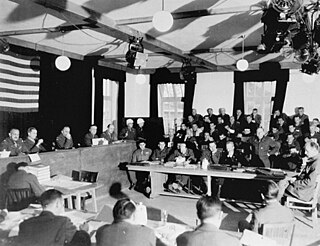
Fresnes Prison is the second largest prison in France, located in the town of Fresnes, Val-de-Marne, south of Paris. It comprises a large men's prison of about 1200 cells, a smaller one for women and a penitentiary hospital.

Mauthausen was a German Nazi concentration camp on a hill above the market town of Mauthausen, Upper Austria. It was the main camp of a group with nearly 100 further subcamps located throughout Austria and southern Germany. The three Gusen concentration camps in and around the village of St. Georgen/Gusen, just a few kilometres from Mauthausen, held a significant proportion of prisoners within the camp complex, at times exceeding the number of prisoners at the Mauthausen main camp.

German Earth and Stone Works was an SS-owned company created to procure and manufacture building materials for state construction projects in Nazi Germany. DEST was a subsidiary company of Amtsgruppe W of SS Main Economic and Administrative Office (WVHA). Both Amt. W and the WVHA were headed by Waffen-SS generals Oswald Pohl and Georg Lörner.

Franz Xaver Ziereis was the commandant of the Mauthausen concentration camp from 1939 until the camp was liberated by the American forces in 1945.

The Dachau trials, also known as the Dachau Military Tribunal, handled the prosecution of almost every war criminal captured in the U.S. military zones in Allied-occupied Germany and in Allied-occupied Austria, and the prosecutions of military personnel and civilian persons who committed war crimes against the American military and American citizens. The war-crime trials were held within the compound of the former Dachau concentration camp by military tribunals authorized by the Judge Advocate General of the U.S. Third Army.

Lungitz is a village in the community of Katsdorf, Perg district of Upper Austria, Austria.
The Mauthausen-Gusen camp trials were a set of trials of SS concentration camp personnel following World War II, heard by an American military government court at Dachau. Between March 29 and May 13, 1946, and then from August 6 to August 21, 1947, a total of 69 former camp personnel were tried. Among them were some of the former guards at the Mauthausen-Gusen concentration camp system and August Eigruber, a former Gauleiter of Upper Austria.

Otakar Batlička was a Czech adventurer, journalist, ham (amateur) radio operator, and member of the Czech-based Nazi resistance group Obrana Národa during World War II.

Père (Father) Jacques de Jésus, OCD, was a French Roman Catholic priest and Discalced Carmelite friar. While serving as headmaster of a boarding school run by his order, he took in several Jewish refugees to protect them from the Nazi government of occupation, for which he was arrested and imprisoned in various concentration camps.

Patrick K. O’Donnell is an American author of books on military history.
The Austrian SS was that portion of the Schutzstaffel (SS) membership from Austria. The term and title was used unofficially. They were never officially recognized as a separate branch of the SS. Austrian SS members were seen as regular personnel and they served in every branch of the SS.
Rudolf Anton Haunschmied is an Austrian author and local historian.
Joseph Morton was an American war correspondent for the Associated Press (AP) in the European Theater during World War II. On December 26, 1944, a Nazi counter-partisan unit named "Edelweiss" stormed a log cabin high on Homolka Mountain in today's Slovakia which housed 15 Allied intelligence officers, a Slovak officer, a Slovak-American interpreter, two Slovak civilian resistance fighters, and Morton himself, covering an OSS operation in the country for a story. Although the Allied officers were duly uniformed and Morton had a war correspondent ID in order to be treated as prisoners of war according to the Geneva Convention (1929), the SS headquarters, in compliance with the Commando Order—which stated that all Allied commandos should be killed immediately without trial, even those in proper uniforms—ordered the summary execution of Allied officers and others caught in the act. On January 24, 1945, Joseph Morton, along with 13 Allied officers, was executed at the Mauthausen-Gusen concentration camp. He was the only Allied correspondent to be executed by the Axis during World War II.

Friedrich Karl Hermann Entress was a German camp doctor in various concentration and extermination camps during the Second World War. He conducted human medical experimentation at Auschwitz and introduced the procedure there of injecting lethal doses of phenol directly into the hearts of prisoners. He was captured by the Allies in 1945, sentenced to death at the Mauthausen-Gusen camp trials, and executed in 1947.

Hans Maršálek was an Austrian typesetter, political activist, detective, historian, and suspected spy for the Soviet Union. A devout socialist and active in the resistance, he was arrested by the Nazis and imprisoned in the Mauthausen concentration camp. After the war, he joined the Austrian political police and was instrumental in tracking down and convicting numerous Nazi criminals. He also became the main chronicler of the camp's history, helped establish the Mauthausen Memorial Museum, and published several books.
Albert Sauer was a Nazi German commandant of Mauthausen-Gusen concentration camp. He died of wounds in 1945, and was never tried for his role in The Holocaust.
Anna Strasser was an Austrian resistance activist during World War II who helped forced-labour and concentration-camp victims until her arrest in 1944.

Gusen was a subcamp of Mauthausen concentration camp operated by the SS between the villages of Sankt Georgen an der Gusen and Langestein in the Reichsgau Ostmark. Primarily populated by Polish prisoners, there were also large numbers of Spanish Republicans, Soviet citizens, and Italians. Initially, prisoners worked in nearby quarries, producing granite which was sold by the SS company DEST.











